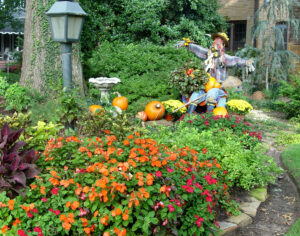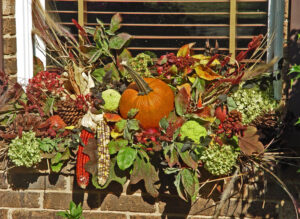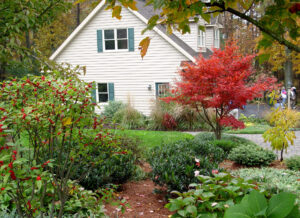Giving Up Already? Not So Fast…
October 31st, 2023
Are you one of those gardeners who already has buzzed everything to the ground and packed away the trowels for the season?

Lots of life and color is possible in the fall garden… if you plan for it.
Not so fast.
As the sage philosopher Yogi Berra once pointed out, “It ain’t over till it’s over.”
And in the garden, it ain’t over until it’s really cold and the ice and snow are flying. Regularly.
Diehard gardeners know that some of the year’s best times in the garden are in mid fall – especially those warm days that inevitably pop up after the season’s first killing frost.
The way our weather has been going these last 10 or 20 years, the so-called “gardening season” now can stretch into mid-November.
The season’s first frost might knock out the summer vegetables and annual flowers, but many perennials bloom on, the trees and shrubs are holding fall-foliage color later than ever, and early-November temperatures typically reach into the 50s – if not higher.
Yet a lot of gardeners do a “fall cleanup” when the first leaves turn, set out the obligatory mums, pumpkins, and straw bales, then call it a year.
Some of it could be that people are tired of the work, tired of the bugs, and just plain tired in general. They’ve had enough and are ready to “put the garden to bed” for another year.
Others are eager to turn the page and shift into Thanksgiving and Christmas mode.
And for others, it’s just what you’re supposed to do come fall and frost.

This fall-themed window display is one way to add interest to the fall landscape while everyone else is removing things.
Contributing to all of that, I think, is that most of our fall landscapes aren’t very interesting. Too often, there’s not a whole lot to keep going in the first place, other than the mums that so many gardeners and non-gardeners buy to keep the fall yard from being a total fizz.
That goes back to the popular view that gardening is a spring thing. Most people go to the garden center only in May, and so they load up on azaleas, lilacs, annuals, and anything that happens to look good in a pot then.
Come fall, instead of a last hurrah, the result is a landscape more akin to the final dirty suds going down the drain after the dishes are done.
Our yards can look full and vibrant well into fall, but it takes some planning and a specific effort to include plants that have showy features in October and beyond.
Perennials such as asters (pink, purple, and lavender), perennial sunflowers (bright gold), Montauk daisies (snow white), Mexican bush sage (purple), and sedum (russet) are among the many fall-bloom options.
Lots of shrubs add the vibrant color of fall fruits and berries, such as the metallic-purple, BB-sized fruits of purple beautyberry, the bright-red berries of viburnums, and the orange, gold, or red pea-sized fruits of winterberry hollies.

Winterberry holly, left, and Japanese maple, right, add bright fall color to this landscape.
Best of all is fall leaf color, ranging from the burgundy leaves of oakleaf hydrangeas to the red-gold shades of fothergillas to the mix of warm shades on so many of our landscape trees, especially dogwoods, stewartia, ginkgo, serviceberry, and parrotia.
In her 2007 book “Fallscaping” (Storey Publishing, $22.95 hardcover), Stephanie Cohen suggests planning a garden in thirds so that one-third of the action occurs in each of spring, summer and fall.
Besides milking every last possible day out of your plants, not mowing the whole yard down by now is more nature-friendly. Premature plant ejection takes away seed heads, shelter, and nest-building material that birds and future butterflies need over winter.
Packing it all away in October also forfeits precious time when we could be out there – bug- and sweat-free – improving the landscape or getting a jump on next spring’s to-do list.
If you don’t mind a little frost on your fingers, you might even still be tending the perennials while the neighbors are putting up their Christmas lights.
Read George’s PennLive column on 18 plants with stunning fall foliage
Read George’s PennLive column on 10 plants that look their best in fall
Read George’s website post on 10 plants with really neat fruits







